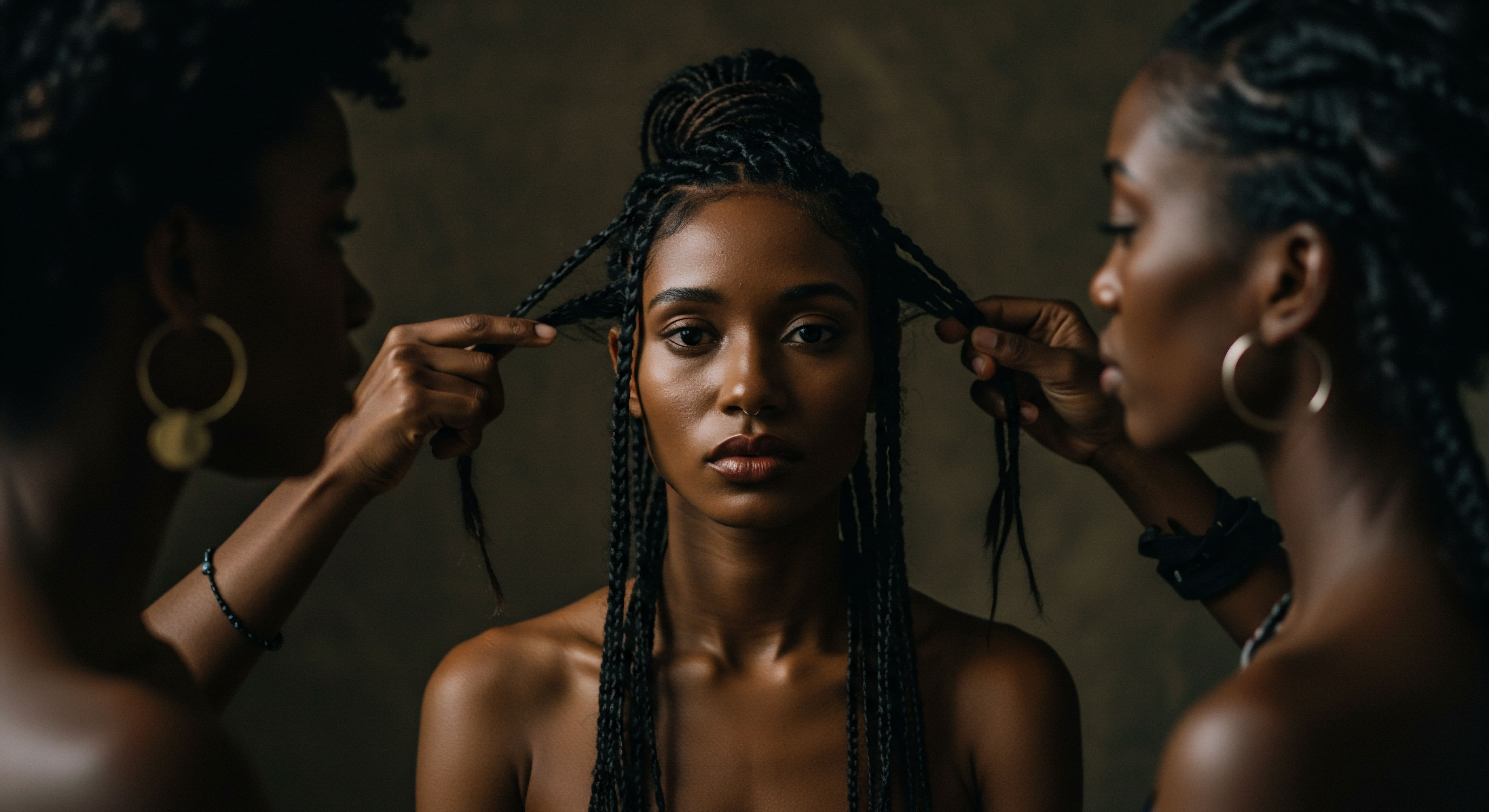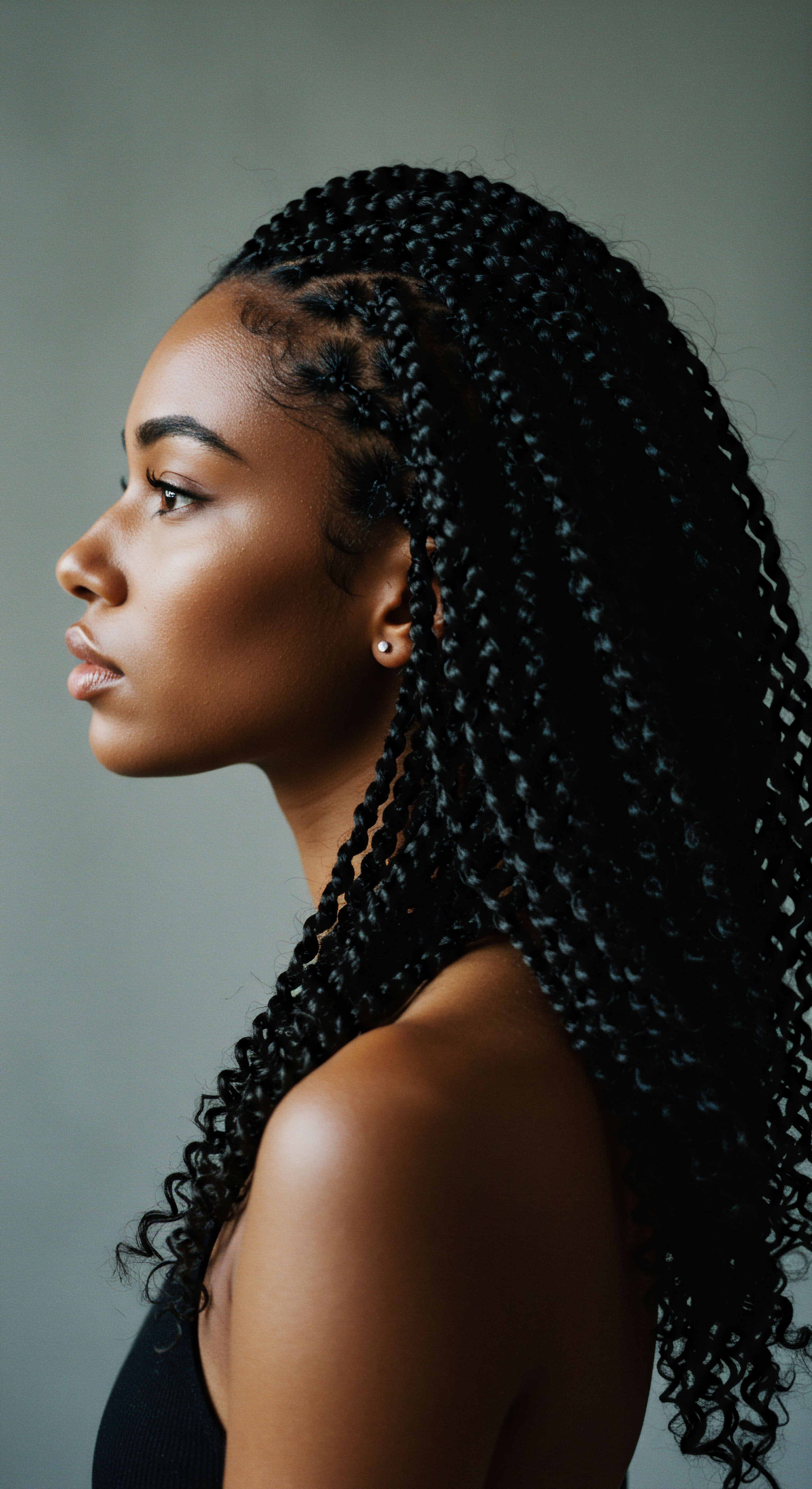
Roots
Consider for a moment the gentle whisper of history, carried on the very strands of hair. Before the age of bottled concoctions and complex labels, communities across the globe, particularly those with a deep connection to textured hair, intuitively understood the subtle language of moisture. Their practices, passed down through generations, were not merely rituals of beauty; they were sophisticated responses to the intrinsic needs of the hair fiber, shaped by keen observation and a profound relationship with the natural world. This ancestral wisdom, seemingly simple, laid the groundwork for what science now meticulously details as the biophysical principles of hydration.
A closer look at textured hair, often characterized by its beautiful coils and curls, reveals a unique architecture. The hair shaft, a complex protein structure, emerges from the scalp with a distinct helical path. This natural curvature, varying from gentle waves to tight z-patterns, affects how natural oils from the scalp descend along the strand.
Unlike straighter hair types where sebum can glide down with relative ease, the twists and turns of textured hair create interruptions, making it more challenging for these protective lipids to reach the ends. This structural reality meant that external applications of moisturizing agents became not a luxury, but a fundamental aspect of care.

What Makes Textured Hair Distinct?
The foundational scientific principles begin with the very building blocks of hair. Each strand is primarily composed of keratin, a fibrous protein. The outer layer, the Cuticle, consists of overlapping scales, much like shingles on a roof.
For textured hair, these scales tend to be more lifted or less tightly packed, especially at the points of curvature. This arrangement, while contributing to the hair’s remarkable volume and elasticity, also creates pathways for moisture to escape.
Beneath the cuticle lies the Cortex, the hair’s main body, responsible for its strength and elasticity. The medulla, a central core, may or may not be present, particularly in finer strands. The specific arrangement of keratin proteins within the cortex, influenced by genetics, dictates the hair’s curl pattern. This inherent structure plays a substantial role in how hair interacts with water and environmental humidity.
Historical hair care practices, born from observation, intuitively addressed the unique structural demands of textured hair for moisture retention.
Historical societies, without microscopes or chemical analyses, understood these vulnerabilities through direct experience. They observed how their hair responded to dry air, sun, and daily manipulation. Their solutions, drawn from local flora and fauna, served as emollients, humectants, and occlusives – categories we now define scientifically. They used plant oils like olive, sesame, and moringa, alongside animal fats, recognizing their ability to coat the hair, add pliability, and shield it from desiccation.

How Did Early Practices Recognize Hair Needs?
Early practices often centered on the idea of sealing. After cleansing, perhaps with saponin-rich plants or clays, a layer of oil or butter was applied. This wasn’t merely for shine; it was a deliberate act of protection.
The science confirms that lipids, being hydrophobic, repel water, thus slowing down its evaporation from the hair shaft. This ancient wisdom, rooted in empirical knowledge, mirrors our modern understanding of lipid barrier function.
- Hair Anatomy ❉ Textured hair exhibits an elliptical cross-section and a curved follicle, influencing curl pattern and oil distribution.
- Cuticle Layer ❉ The outermost protective layer, often more open in textured hair, making it prone to moisture loss.
- Keratin Proteins ❉ The primary component of hair, forming complex structures that dictate its inherent curl and strength.
The understanding that external elements were needed to supplement the hair’s natural defenses was a cornerstone of historical care. This deep-seated recognition of hair’s elemental needs, before formal scientific classification, represents a profound connection to the body and its interaction with the surrounding world. It speaks to a wisdom that was both practical and deeply reverent of the hair’s natural state.

Ritual
Stepping from the foundational insights into the daily rhythms of care, we encounter the practices themselves—the gentle application of oils, the deliberate styling, the protective coverings. These actions, often imbued with cultural meaning, were meticulously designed to maintain the hair’s suppleness and vibrancy. The transition from a dry, brittle state to one of soft, hydrated vitality was a tangible result of these sustained efforts, revealing an intuitive grasp of moisture management.
The act of oiling the hair, prevalent across many ancient cultures, was more than a cosmetic step. It was a primary means of hydration. Ancient Egyptians, for instance, used a variety of plant-based oils, such as sesame, castor, and moringa, along with animal fats, to condition and protect their hair.
These applications served as occlusive agents, forming a barrier on the hair’s surface that reduced the rate of water evaporation. This simple yet effective method of sealing moisture within the hair shaft prevented the dryness and breakage that textured hair is particularly susceptible to.

What Did Ancient Hair Oils Accomplish?
The scientific principles at play in these historical oiling rituals are straightforward yet potent. Oils, being primarily composed of lipids, possess a hydrophobic nature. When applied to hair, they create a thin film that diminishes the rate at which water molecules escape from the hair’s interior into the surrounding atmosphere. This phenomenon, known as the Occlusive Effect, is crucial for textured hair, which, due to its helical structure and often more open cuticle, tends to lose moisture more rapidly than straighter hair types.
Beyond simple occlusion, many traditional oils contain fatty acids and other beneficial compounds that can penetrate the hair shaft to some degree, particularly if the hair is slightly damp. For example, coconut oil, a staple in many tropical cultures, has a molecular structure small enough to partially penetrate the hair cortex, offering internal conditioning in addition to surface protection. This dual action of surface sealing and internal conditioning contributed significantly to the hair’s overall hydration and resilience.
The consistent application of natural oils in historical hair practices provided essential surface protection and internal conditioning.
Another significant aspect of historical practices involved the use of humectants. While not always recognized as such, ingredients like honey, a common additive in historical hair treatments, possess the ability to draw moisture from the air into the hair. When combined with oils, which then lock in this newly acquired moisture, a powerful hydration system emerges. This layering of products, even if not consciously understood in chemical terms, maximized the hair’s ability to retain water.

How Did Protective Styling Aid Hydration?
Protective styling, such as braiding, twisting, and coiling, also played a vital role in moisture preservation. By gathering strands into larger, more cohesive units, these styles reduced the hair’s exposure to environmental factors like wind and dry air, which accelerate moisture loss. Furthermore, these styles minimized daily manipulation, which can lead to mechanical damage and cuticle lifting, both of which compromise the hair’s ability to retain hydration. The careful arrangement of hair into these formations effectively created a micro-environment that shielded the individual strands.
| Traditional Agent Plant Oils |
| Common Source Olive, Sesame, Castor, Moringa |
| Primary Scientific Action Occlusion, Emollience (surface coating, moisture barrier) |
| Traditional Agent Animal Fats |
| Common Source Ox, Sheep, Fowl Fat |
| Primary Scientific Action Occlusion, Emollience (surface coating, moisture barrier) |
| Traditional Agent Honey |
| Common Source Bee Products |
| Primary Scientific Action Humectancy (draws moisture from air) |
| Traditional Agent Aloe Vera |
| Common Source Aloe Plant |
| Primary Scientific Action Humectancy, Soothing (mucopolysaccharides bind water) |
| Traditional Agent These agents provided a comprehensive approach to maintaining hair hydration through varied mechanisms. |
The emphasis on gentle handling and minimal manipulation, often a byproduct of these styling methods, further contributed to hair health. Detangling wet hair, for instance, a practice still recommended today, reduces mechanical stress and breakage, preserving the integrity of the hair shaft. The cumulative effect of these practices—from the selection of moisturizing agents to the choice of protective styles—created a holistic regimen that addressed the inherent hydration needs of textured hair, long before the advent of modern cosmetic chemistry.

Relay
As we move into a deeper examination, the historical practices of textured hair hydration reveal a remarkable synergy with contemporary scientific understanding. It is here that the interplay of biological structure, environmental factors, and cultural wisdom becomes most apparent, inviting a closer look at why these age-old methods persist and continue to be relevant. The complexities of textured hair’s interaction with water, often misunderstood, are brought into sharper focus by recent research, which in turn validates the ingenuity of ancestral care.
One of the most intriguing findings in recent trichological research concerns the lipid content of textured hair. Counter-intuitively, studies indicate that Afro-Textured Hair Possesses the Highest Overall Lipid Content compared to European and Asian hair types, with quantities estimated to be 2.5 to 3.2 times greater. Despite this abundance of natural lipids, Afro-textured hair is frequently characterized by dryness. This apparent paradox is not due to a lack of lipids, but rather to the hair’s unique morphology.
The pronounced curvature and elliptical cross-section of textured hair create areas of weakness and hinder the efficient distribution of sebaceous oils from the scalp along the entire hair shaft. These structural characteristics also contribute to a more porous cuticle, allowing moisture to escape more readily, even with a robust internal lipid profile. This scientific insight underscores why historical practices focused so heavily on external lipid application – they were intuitively compensating for a structural challenge that impeded natural moisture distribution.

Why Do Textured Hair Structures Affect Hydration?
The very shape of the hair strand dictates its hydration dynamics. The helical twists and turns mean that the cuticle scales, which are the hair’s primary defense against moisture loss, are not uniformly flat against the cortex. At the points of curvature, these scales can be more lifted or prone to damage, creating avenues for water molecules to escape.
This increased surface area and exposed cuticle make textured hair particularly susceptible to dehydration, even in humid environments. The science of Water Sorption and Desorption in hair demonstrates that textured hair, despite its higher lipid content, exhibits lower radial swelling in water compared to other hair types, which can be linked to its specific lipid composition and structural impediments to water penetration and retention.
The biomechanical properties also play a role. Textured hair is often described as more fragile and prone to breakage, not because it is inherently weak, but because the points of curvature represent stress points. Mechanical manipulation, such as combing or styling, can cause breakage at these junctures. Historical practices of protective styling, like intricate braids and twists, served to minimize this manipulation, thereby preserving the hair’s integrity and, consequently, its ability to hold moisture.
The high lipid content of textured hair, coupled with its unique structural geometry, explains its paradoxical dryness and the necessity of external hydration.

How Did Traditional Remedies Address Porosity?
Hair porosity, which describes how well hair absorbs and retains moisture, is often higher in textured hair types. This means the hair readily takes in water, but also loses it just as quickly. Traditional remedies, whether through the use of heavy oils or specific plant extracts, acted as early forms of porosity management.
Consider the application of heavy butters or waxes. These substances, rich in long-chain fatty acids, created a substantive barrier on the hair’s surface. This barrier effectively lowered the hair’s effective porosity, slowing down both the absorption and, critically, the desorption of water. This approach, intuitively applied for centuries, mirrors modern cosmetic science’s use of occlusive agents to seal the cuticle and prevent moisture evaporation.
- Lipid Paradox ❉ Textured hair has high lipid content but is prone to dryness due to structural characteristics impeding oil distribution.
- Cuticle Integrity ❉ Curvature can lead to lifted cuticles, increasing water evaporation.
- Mechanical Vulnerability ❉ Stress points in coils make hair more susceptible to breakage, impacting moisture retention.
The cultural significance of these practices also speaks to a deeper understanding. Hair was, and remains, a powerful symbol of identity, heritage, and health. The careful, often communal, rituals of hair care were not just about aesthetics; they were acts of preservation, nurturing, and connection.
The meticulous attention paid to hydration ensured the hair remained pliable enough for complex styles, reflecting social status, age, or marital standing. This intertwined cultural and scientific understanding paints a complete picture of why historical practices for textured hair hydration were so remarkably effective and enduring.

Reflection
The journey through the scientific principles underpinning historical practices for textured hair hydration reveals a timeless wisdom. It is a testament to the enduring power of observation and adaptation, long before the advent of laboratory analysis. The delicate balance of structure and moisture, the ingenious use of nature’s offerings, and the profound cultural connections woven into each strand of hair continue to resonate. As we look to the future of textured hair care, the echoes of the past offer not just guidance, but a quiet invitation to honor the inherent beauty and resilience of these unique hair patterns, forever hydrated by both ancestral knowledge and the deepening insights of science.

References
- 1. Bijauliya, R, et al. “A comprehensive review on herbal cosmetics.” International Journal of Pharmaceutical Sciences Review and Research, vol. 8, 2017, pp. 4930–4949.
- 2. de la Mettrie, R, et al. “Physicochemical Properties of Textured Hair.” Journal of Cosmetic Science, vol. 72, 2021, pp. 711–731.
- 3. Davis, Kam. “A Science-Based Guide to Afro-Textured Hair Care from Nylah’s Naturals.” Nylah’s Naturals, 2024.
- 4. Loussouarn, G. “African hair exhibits the lowest radial swelling percentage in water because of its high apolar lipid levels compared to those of Asian and European hair.” International Journal of Cosmetic Science, vol. 35, no. 5, 2013, pp. 491-499.
- 5. Mirmirani, P. “Hair Care Practices in African-American Patients.” Seminars in Cutaneous Medicine and Surgery, vol. 28, no. 2, 2009, pp. 103-108.
- 6. Ng, L. “The Genomic Variation in Textured Hair ❉ Implications in Developing a Holistic Hair Care Routine.” Preprints.org, 2024.
- 7. Sherrow, V. Encyclopedia of Hair ❉ A Cultural History. Greenwood Press, 2006.
- 8. Sherman Roberts, J. “‘Used With Constant Success’ ❉ Animal Ingredients in Eighteenth-Century Remedies, and their Success in the Beauty Industry.” The Recipes Project, 2018.
- 9. Singh, S. “Indian medicinal plants used in hair care cosmetics ❉ A short review.” Pharmacognosy Journal, vol. 2, 2010, pp. 361–364.
- 10. Spengler, M. “Contemporary African-American Hair Care Practices.” The Journal of Clinical and Aesthetic Dermatology, vol. 8, no. 5, 2015, pp. 46–50.
- 11. Trexler, D. “The Legacy of Lathers ❉ Tracing the Historical Use of Natural Ingredients in Hair Cleansing.” Hello Jupiter, 2023.
- 12. Walker, A. “Hair Care Science for Afro Hair.” Reddit r/HaircareScience, 2025.
- 13. Wolfram, L. J. “Hair ❉ Physical Properties.” In Cosmetics & Toiletries Magazine, vol. 120, no. 9, 2005, pp. 43-48.
- 14. Zaid, S. “The Influence of Hair Lipids in Ethnic Hair Properties.” ResearchGate, 2023.